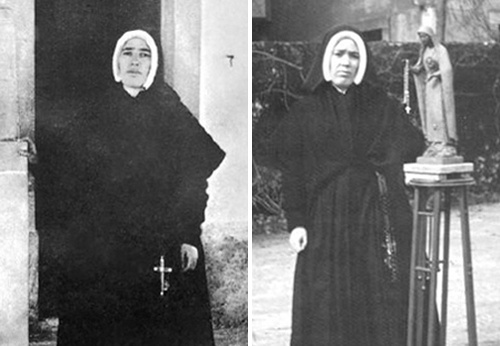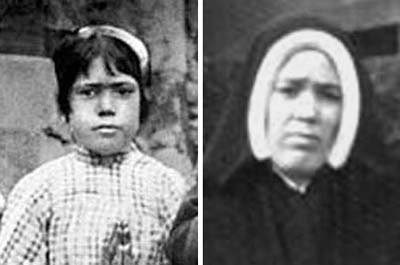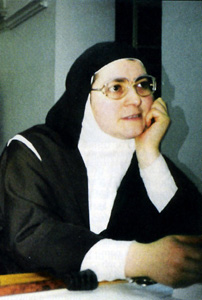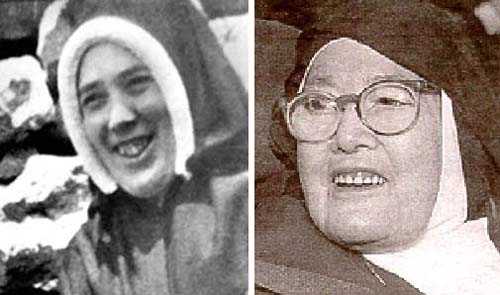 |
Fatima Issues
Two Sister Lucys of Fatima?
Marian T. Horvat, Ph.D.
I recently came upon some seldom seen pictures of Sister Lucy of Fatima, who was born in 1907. In the first photo below left, she is visiting the Chapel of the Apparition in Fatima. She looks like a nun in her early 30s, but the Fatima Archives report the date of the visit as 1946, so she would be 39-years-old. In the second photo, she poses near a statue of the Immaculate Heart of Mary sculpted for the Chapel of the Apparitions. She appears older in this picture, but since she still wears the habit of the Sisters of St. Dorothy, at most she could be age 41, since she left that Order in 1948 to become a Carmelite in the Convent in Coimbra, Portugal.

At left, Sister Lucy at the Chapel of the Apparitions in 1946;
at right, viewing a statue of Our Lady for the Chapel
|

Lucia dos Santos, age 10 Sister Lucy around 40-years-old |
In these photos, one can see in Sister Lucy some traces of the child Lucy who was favored with the visit of the Mother of God at age 10 in 1917.
The same flat face, the same chin, the same thick lips, the same broad nose and small eyes under heavy brows that make a straight line separating the eyes from the forehead. One has no difficulty believing that these pictures of Sister Lucy are, in fact, of the same person as the child Lucia de Santos.

"Sister Lucy as a young nun"
Inside the Vatican, March 2006 |
Having recently carefully examined these pictures of Sister Lucy, I was truly taken aback to see a photo representing Sister Lucy published in the March 2006 issue of Inside the Vatican. The caption reads, “Here, a rare photo of her as a young nun.”
This nun is dressed in a Carmelite habit; therefore, she would have to be at the very least 41-years-old since Sister Lucy only entered the Carmel in 1948 at age 41. My inquiry to Inside the Vatican about the exact age of Sister Lucy in this photo still has not received a response. Therefore, one can suppose that she is in her 40s.
Making a close inspection of this photograph, however, one does not find the same features of the Sister Lucy I pointed out above.
I invite my reader to make a comparison of the photos with me. For the sake of precision, permit me to call the person in the set of earlier photos Sister Lucy I, and the person shown at left in the Inside the Vatican picture and later photos Sister Lucy II.
In the first set of pictures to be compared below, the faces are serious. In the next set further down below, they are smiling.

Sister Lucy I, in her early 40s Sister Lucy II, in her 40s or early 50s
|
The first point that catches one’s attention is the difference of age of both persons. At left above Sister Lucy I is at an age that cannot be older than 41. At right above is Sister Lucy II, at an age that cannot be younger than 41. However, the person on the left looks much older than the one on the right. It is difficult to imagine that with a few years of difference, the suffering somber face of the Dorothean Sister at left could have changed into the cheerful, positive countenance of the young Carmelite at right.
But the age is not the only point of discrepancy.
- Analyzing the faces, one can see that Sister Lucy I has an oval face with high cheekbones and a concave chin; Sister Lucy II has a squarer face and jaw.
- The lips of Sister Lucy I are thick and generous; the lips of Sister Lucy II are very thin and tight.
- When Sister Lucy I smiles, below left, one can see that the mouth forms the shape of a U with the edges pointing upward. When Sister Lucy II smiles, the edges of the lips point downward in the shape of an upside-down U.
- The nose of Sister Lucy I is broad. The nose of Sister Lucy II is longer and more narrow, with a rounding curve that turns under at its tip forming a lobe, as can be seen above right.
- Sister Lucy I has small eyes that normally squint. Very little of the white of the eyes appears. Sister Lucy II has large, bulging eyes with a good amount of white appearing.
- The eyebrows of Sister Lucy I are straight and very heavy from one end to the other, coming together closely in the middle of her forehead. Sister Lucy II has lighter arched eyebrows that taper off in width at the ends. It is clear that there is a large space over her nose without any eyebrows. This notorious difference between the brows of the two persons is slightly disguised by the use of large glasses.

When Sister Lucy I smiles her mouth forms a U. When Sister Lucy II smiles her mouth forms an inverted U
|
These are the physical features that, as far as I can judge, are different in the two persons.
The appearance of glasses on Sister Lucy II also raises a question. The glasses of Sister Lucy II seem to have thick lenses, which speaks of nearsightedness. However, Sister Lucy I never appeared with glasses up to her 40s. It is worth considering that most serious cases of nearsightedness show up before this age. Furthermore, if one observes the pictures of the down-to-earth peasant family of Sister Lucy I, there is no one using eyeglasses. It would not seem to be a problem that runs in the family.
One could also consider the postures and gestures of the two Lucys. Sister Lucy I stands in a collected way, her hands in a discrete gesture. Her posture and demeanor are quite composed, as befitting a religious woman.
The pose of Sister Lucy II as a young nun is in many senses different. She rests her face on her hand as if she were in a classroom listening to a lecture. Her somewhat artificial air catches one’s attention. Her wrists are deliberately showing, as well as a small bit of her hair at the top and side of the habit, more in keeping with the manner of a progressivist nun, clashing with the extreme discretion of Sister Lucy I.
Sister Lucy II’s glasses are very modern in style for a nun of the 1950s. One can certainly say that it reflects a person sensitive to the appeals of fashion. Again, an attitude foreign to Sister Lucy I.
These are the comparisons I would like to offer to my reader. My conclusion is simple: the face, the features, the gestures, and the spirit of the two Sister Lucys are dissimilar. It would seem, then, that we are looking at two different persons.
If this is true, we would have been duped by some impostor who was presented as the authentic witness of the visions of Our Lady.
In this case, some hypothetical questions arise. What happened to the true Sister Lucy? When was the replacement made? And more importantly, why was such an exchange necessary?
Perhaps if we ask the classical question – Cui bono? [Who benefits?] – the answer emerges. The retirement of Sister Lucy I and introduction of Sister Lucy II before 1960, the year the secret was to have been revealed, would prevent the true witness from telling the world the full content of the Third Secret. This could only have been to the benefit of the progressivist wing that is dominating the Church in our days.


Related Topics of Interest
 Photos and Facts - The Two Sister Lucy's Photos and Facts - The Two Sister Lucy's
 A Mislabled Photo - You Are Conspiracy Maniacs A Mislabled Photo - You Are Conspiracy Maniacs
 Wildfire Spreading over Sister Lucy's Photos Wildfire Spreading over Sister Lucy's Photos
 Readers Concur - There Are Two Sr. Lucys Readers Concur - There Are Two Sr. Lucys
 The Controversy Grows on the Two Sister Lucys The Controversy Grows on the Two Sister Lucys
 Forebodings about the Death of Sister Lucy Forebodings about the Death of Sister Lucy
 The Progressivist Challenge to Fatima The Progressivist Challenge to Fatima
 Tears, a Miraculous Warning Tears, a Miraculous Warning
 Our Lady of Good Success and Our Lady of Fatima Our Lady of Good Success and Our Lady of Fatima
 The Myth of a Converted Russia The Myth of a Converted Russia

Related Works of Interest
|
Fatima | Hot Topics | Home | Books | CDs | Search | Contact Us | Donate

© 2002- Tradition in Action, Inc. All Rights
Reserved
|
 |
|

|